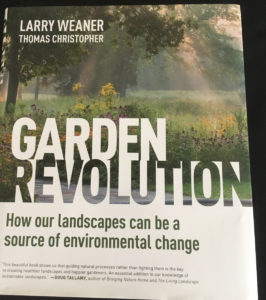 Garden Revolution: How our landscapes can be a source of environmental change
Garden Revolution: How our landscapes can be a source of environmental change
Garden Revolution is a collaboration between a horticulturist, Thomas Christopher, and a landscape designer, Larry Weaner, who both care deeply about creating sustainable landscapes and leading us all to the conclusion that our gardens can be engines of ecological renewal. Although the book is a collaboration, it is told in Weaner’s voice.
The central thrust of the book is the notion that conventional gardening is counter-productive, relying on tilling, irrigation and fertilization, thus perpetually disturbing the natural ecology of our sites. The suggested alternative is basing our design and gardening on the study of how plants and wildlife interact. The result will be less human input and an ability to better cope with weeds and pests. Instead of attempting to keep the original design static, Christopher and Weaner suggest that we should subtly direct the evolution of the garden. Instead of consuming natural resources and polluting the environment, we can use our gardens to cope with storm water and advance biodiversity.
I was fascinated by the debunking of traditional horticultural practices such as pulling weeds, amending soil, and raising the ph of acidic soil to make nutrients more available. Instead, following the authors’ design path will lead you to partner with nature, ensuring that the garden is never finished, that it will always be a work in progress. Introducing the element of time to the garden means that it will evolve. This does not mean that there will be no garden editing, just that you will guide it. For instance, letting plants seed in the garden creates a spontaneous event; we never know where they will end up. Are there more than we want? We can transplant them or give them away.
Before attempting to design ecologically, Weaner believes that we need to understand the vocabulary and thus gives us a primer, defining each term and its relationship to a functional landscape. He also encourages us to identify the site’s ecological conditions and inventory the plants on site, both desirable and undesirable. The combination of these factors will guide us to plant communities and choices that will ultimately mean less maintenance and a more sustainable landscape. Finally, he stresses how knowledge of the site’s past and present vegetation will impact future vegetation.
As Weaner discusses creating an ecologically connected master plan, he quotes the old maxim “First, do no harm.” Preserving what is there is easier and less expensive than restoring a damaged site. There may be several different habitats on a property and creating correctly sized and shaped corridors to connect them is crucial. Once the overall design is complete, one can finally start selecting plants. Weaner emphasizes the importance of selecting plant communities, not just individual plants. One of the thrusts of the book is that we need to design and garden in non-traditional, horticultural ways. An essential element of this philosophy is changing the traditional spacing of plants so as not to leave gaps that will be filled, naturally, with weeds. Including groundcovers to create a dense ground layer will preclude a great deal of maintenance; if the ground is shaded, weed germination will be minimal.
Design and implementation are only the beginning with very specific instructions for creating meadows, shrublands, and woodlands. Management of the landscape comes next and Weaner offers many suggestions for weed control¸ watering, soil amendment, establishing a living mulch, managing plant proliferation, and ongoing design. Although the principlesof the authors are applicable to any landscape site, they are most applicable to large areas.
The excellent photos, mostly taken by Weaner, continuously illustrate his design philosophy. This thought-provoking book is a not a fast read because there is so much information to absorb but I learned a lot about the natural world, how it evolves, and how we can use that knowledge in our designs.
Weaner, Larry and Christopher, Thomas, Garden Revolution: How our landscapes can be a source of environmental change, Timber Press, Portland, 2016, $39.95.


0 Comments